Want to know how to use baking soda to raise the pH level of your pool? Read our article on the subject!
Maintaining your pool can be a costly and challenging undertaking. However, there are things you can do to make the process easier and less expensive. For example, by not squandering your hard-earned cash on commercial alkalinity-increasing products when you can use a common, inexpensive compound to do the job: baking soda.
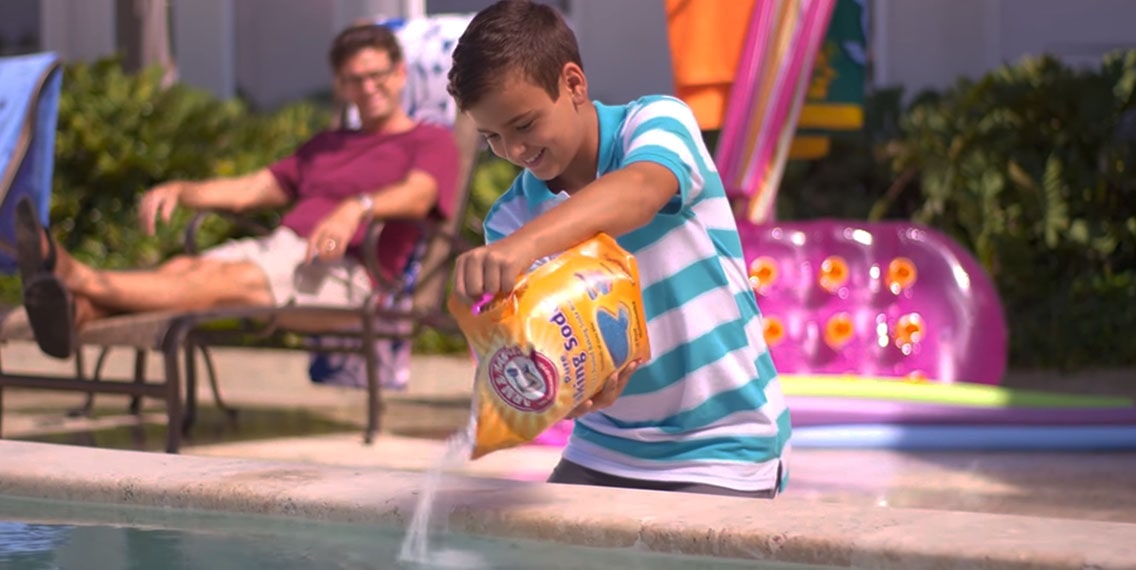
In this article, I’ll cover these points:
- Using baking soda to solve common pool problems
- The difference between pH levels and total alkalinity
- Why pH balance is so important
Let’s dive in!
What are Pool pH Levels?
pH, or “potential hydrogen,” is how well a solution attracts hydrogen ions. It can tell us how alkaline or acidic a liquid is. You measure pH on a scale from zero to 14. Zero means the solution is acidic, while 14 indicates the solution is basic or containing more OH – ions than H + ions.
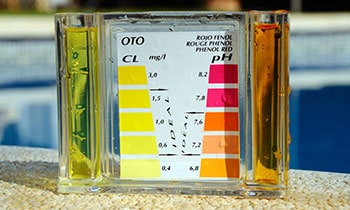
A neutral solution such as pure water falls in the middle of the scale with a pH of seven. A good level for pool water is a pH of 7.5, which means it’s slightly basic. Low pH can be caused by:
- Rainwater
- Debris such as leaves, bugs, and grass clippings
- Human secretions such as body oils, sweat, saliva, and urine
The difference Between pH and alkalinity
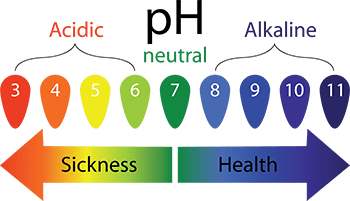
Lots of pool owners get hopelessly confused by the difference between alkalinity and pH. As I already discussed, you measure pH using a scale. On the other hand, you measure total alkalinity in parts per million. This means that total alkalinity is an absolute measure of the concentration of all alkaline substances in a solution.
The most common alkaline substances in a pool are bicarbonate, carbonate, and hydroxides. Alkaline substances are important because of how they affect pH. They act as buffers, preventing pH levels from rising or falling. They do this by neutralizing acids. So, in the end, total alkalinity is a measure of how strongly pool water resists changes in pH levels.
Why pH Balance is Important
Maintaining the correct pH balance not only keeps your swimming pool sparkling clean but also helps preserve your pool finish’s aesthetic appeal by preventing it from getting stained. pH balance is also essential to ensuring the longevity of your pool and its components.
Pools need to have a pH level of between 7.2 and 7.8. Pool water with pH levels that are low is acidic. This kind of water is corrosive and can lead to pumps and other equipment breaking down. Basically, everything that acidic water touches gets worn away, including accessories, plumbing, and other parts of the pool system.
Unbalanced pH levels can also wear down pool liners and ladders, causing them to become brittle and crack. Improper pH levels can even strip the copper right out of heat exchangers.
The Relation of pH Levels to Chlorine

Everyone knows that chlorine is vital in keeping pool water healthy and safe for swimmers. However, elevated pH levels can decrease chlorine’s effectiveness, leading to unsanitary swimming conditions.
On the other hand, adding too much chlorine can lower your pool’s pH balance. This can cause health problems for swimmers, including irritated skin, eyes, and the nasal cavity’s mucous membranes. This is because acidic water strips away the body’s natural oils.
When your pool water’s alkalinity is too low, any chemicals you add can create a condition known as pH bounce. pH bounce is when the water rapidly cycles between acidic or basic pH levels, making the water unsafe for swimmers. pH bounce means you’ll have to keep adding more chlorine to achieve the same sanitizing effect.
How to Raise pH in Pool
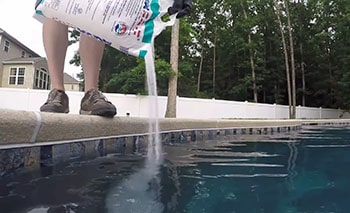
Adding baking soda, an ingredient commonly found in most kitchens, to your pool water raises both its pH and alkalinity. Many commercial pool products have baking soda as their primary active ingredient. This means you can save yourself wads of cash by purchasing baking soda instead of an overpriced commercial pool product. Because you’ll be adding up to 10 pounds of baking soda to your water, it’s more cost-effective to buy your baking soda in bulk.
However, you’ve got to be careful because it’s easy to go overboard. If you do, you’ll go from a low pH problem to a high pH problem in a matter of no time. Here are the steps you’ll need to follow to keep your pool’s alkalinity at optimal levels by using baking soda:
- Test your pool’s alkalinity every day. The optimal pH level is between 7.2 and 7.8, and the ideal alkalinity range is between 100 and 150 parts per million. If your alkalinity level is lower than 80 ppm, you need to raise it.
- Determine how much baking soda to add. 1.5 pounds of baking soda per 10,000 gallons of water raises alkalinity by approximately 10 ppm. Start by adding only one-half of the recommended amount. Retest to find out if you need to add more.
- Spread the baking soda across the entirety of your pool’s surface. Avoid dumping it all in one spot. It’s not advisable to do this on a windy day because the powder will get into the air.
- Wait at least six hours for the powder to dissolve. Turning on your pool’s circulation system will help it disperse.
- 24 hours after adding the sodium bicarbonate, retest your pool’s pH and total alkalinity levels. If the pH is under 7.2 and the alkalinity is below 110 ppm, repeat these steps.
Common Pool Problems
Algae
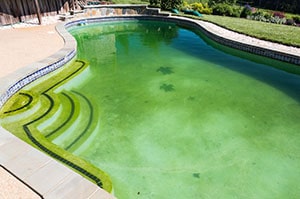
If your pool water is dull green, pool surfaces are slippery, and walls and the pool bottom are slimy, you have a severe algae problem on your hands. This means you’ll need to use an algaecide to kill all the aquatic scum. After applying algaecide, test your pH and alkalinity. Add a little sodium bicarbonate to raise alkalinity levels to at least 100 ppm and pH to between 7.2 and 7.8.
Corrosion
Say your ladder is corroded, or you see pits on your pool tiles or liners. In that case, the alkalinity level of your water is abnormally low. Add sodium bicarbonate to get the levels back up to where they should be. You’ll probably need eight pounds or more if the levels are low enough to cause corrosion.
Cloudy Pool Water
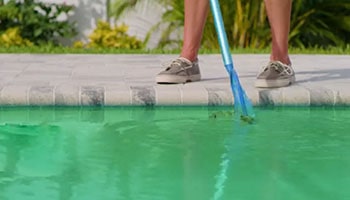
Cloudy pool water can be caused by a couple of things. Start by checking your pool’s filtration system.
If that isn’t the culprit, test the hardness level of your household water supply. If it’s hard, immediately stop using any pool products that contain calcium.
The easiest remedy for cloudy pool water is by super chlorinating it. This means temporarily increasing the chlorine levels in your pool to boost its sanitizing power. Test the water after adding the chlorine, and slowly add baking sodium to get the pH level to between 7.2 and 7.8.
Final Thoughts
So, there you have it—all the ways you can use baking soda to save money on pool maintenance. It’s hard to believe that such an inexpensive and commonplace compound can make such a big difference in both the way your pool looks and how clean it is. If you’d like more assistance in the battle to keep your pool sparkling, clean, check out these skimmers. What part of this article did you find most helpful? Let me know in the comments!

Pool Maintenance Tips & Tricks
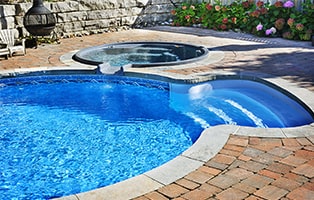

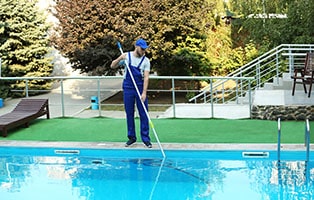

Ideally, you should aim for a target pH level of 7.5, which is neither too acidic not too alkaline. You might not realize that the difference between a level of 7.5 to 7.8, for example, can still have significant negative effects! Maintaining the balance as near to 7.5 as possible maximizes swimmer comfort and helps your set pool and equipment stay in excellent condition.
I’m no chemist so ur article was very clear to understand have some well water in pool so I think I have problems there going to check for calcium . It’s hard to keep everything at a good level . I tell everyone our pool eats better than us . I will keep ur site on all the time thanks.
Luke
Excellent.
Regards
From
Peter van Dijk , Dutch Nationalty
Living in Thailand